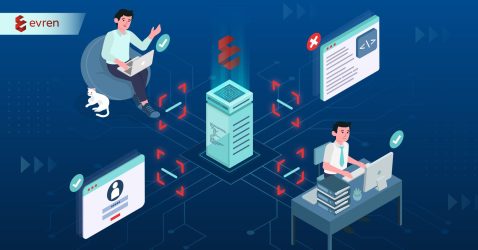Zero Trust is all about a proactive defense, assuming that a breach can occur from anywhere and anyone.
In an age where digital threats have become more sophisticated and pervasive, enterprises worldwide are recognizing the significance of reinforcing their cybersecurity framework. The days of using a perimeter-based security approach, often likened to a “castle-and-moat,” are waning. Instead, the emphasis is shifting towards a security model that assumes no trust by default, appropriately named “zero trust.” Gartner predicts that by 2026, 10% of large enterprises will have a mature and measurable zero-trust program, up from the current 1%.
Understanding Zero Trust
Historically, organizations visualized their cybersecurity strategies much like a fortress. If you were within the protective walls of the “castle” (the company network), you were safe. Outside threats remained – well, outside. This approach, sometimes referred to as “soft center, hard shell” security, sufficed when all organizational systems and data existed on-premise, and everyone operated from a singular office space.
However, the modern digital landscape paints a different picture. Today, most systems are run by SaaS providers, data is handled by multiple third parties, and employees can work and access data from anywhere, often using personal devices. In such an interconnected environment, how do you discern who to trust?
Zero Trust Security posits that no one, regardless of their location or device, should be inherently trusted. Instead, everyone should be verified. To put it succinctly, “trust no one, verify everyone.” In their book Zero Trust Networks: Building Secure Systems in Untrusted Networks, Gillman and Barth note that the fundamental principles of Zero Trust can be distilled into five key assertions:
- Always assume the network is hostile.
- Recognize that both external and internal threats persistently exist.
- Proximity to or within a network doesn’t equate to trust.
- Authenticate and authorize every device, user, and network flow.
- Policies should be dynamic, deriving from as many data sources as feasible
In essence, Zero Trust is all about a proactive defense, assuming that a breach can occur from anywhere and anyone.
Why The Shift to Zero Trust?
At a time when enterprise boundaries are constantly reshaped by remote work, cloud services, and third-party integrations, perimeter security alone is a vulnerable stance. Why? Because malicious entities have myriad access points, and several of these could be external or third-party-owned.
To counter these challenges, Zero Trust demands that organizations operate under the assumption that threats could already exist within their domain. This perspective necessitates an ongoing risk assessment of their infrastructure, prompting solutions that consistently mitigate potential threats. Central to these protective measures is the principle of least privilege, which ensures users have only the minimal access required to perform their tasks.
Benefits of Adopting a Zero Trust Architecture
Adopting a Zero Trust Architecture (ZTA) is not just about addressing vulnerabilities; it’s about harnessing a slew of benefits that fortify an organization’s digital stance.
- Redefining Security Perimeters: ZTA recognizes that perimeters no longer define the scope of security and instead ensure continuous monitoring and verification of access requests, thereby enhancing protection against potential breaches.
- Enhanced Cloud Security: ZTA provides a security model that spans the shared responsibility between the cloud provider and the enterprise, fortifying cloud data protection.
- Safeguarding Third-party Applications: Given the rise of SaaS and PaaS, ZTA operates on the presumption that the network might already be compromised, ensuring rigorous security controls and necessitating authentication for data access.
- Granular Access Control: ZTA ensures that access is granted strictly based on defined dimensions of trust, ensuring that only necessary access is granted, even to privileged users.
- Addressing Remote Work & BYOD Vulnerabilities: ZTA operates on the assumption that remote or BYOD setups might not match the security of office environments and devices, ensuring rigorous and stringent access controls, mitigating potential security breaches.

Reinventing Cybersecurity with Evren’s Zero Trust Model
Evren’s Zero Trust Architecture offers robust, comprehensive security tailored for contemporary challenges through its SaaS Security Platform based on the verify-and-never-trust principle.
Here’s a glimpse into Evren’s process:
- Zero Trust Access Control Decision: The platform makes informed decisions on access controls. No user or entity gets access without a rigorous verification process.
- User Identities Management: Users form the nucleus of Evren’s ZTA. Every user identity is authenticated, ensuring that every interaction within the network is legitimate.
- Endpoint Security Management: Evren’s approach to endpoint security goes beyond just managing them. It meticulously secures each endpoint, ensuring they adhere to strict security protocols. This includes patching software vulnerabilities, monitoring for anomalous behavior, and isolating compromised endpoints to prevent spread.
- Remote Device Management: In the age of remote work and diverse device usage, Evren recognizes the need to securely manage devices that access the network from remote locations. With features like remote wipe, device compliance checks, and more, Evren ensures that remote devices do not become the weak link in the security chain.
- Evren Admin Portal/Evren API: Evren’s Admin Portal provides a centralized view for IT admins to oversee and manage security policies, users, and devices. The API allows for seamless integration with other systems and automated workflows, ensuring that Evren’s security measures can be embedded throughout an organization’s digital landscape.
- Customer Digital Asset: Evren places paramount importance on safeguarding the customer’s digital assets. Whether it’s proprietary software, critical data, or any other digital resource, Evren’s architecture is designed to provide multi-layered protection against threats.

Evren’s Zero Trust Capabilities
Evren’s approach to Zero Trust is comprehensive, categorizing its capabilities into four primary pillars:
- Monitoring, Detection & Response: Evren remains ever vigilant, with tools for threat hunting, EDR, system files monitoring, and kernel auditing, ensuring no malicious activity goes unnoticed.
- Assets & Activities Management: From application sandboxing to comprehensive asset management, Evren ensures that all software and hardware assets are shielded from potential threats.
- Data Integrity, Availability, & Privacy: Evren prioritizes data, offering a robust set of tools including a firewall, advanced DLP, full disk encryption, and remote wipe features to protect an organization’s data assets.
- Authentication & Authorization: Evren’s advanced authentication and authorization capabilities, such as strict user privileges restrictions and 2FA, ensure only legitimate users can access the network.
Towards A Zero Trust Organization with Evren
Transitioning to a zero-trust framework is a collaborative journey. It starts with understanding your unique challenges, requirements, and existing security gaps – through a thorough security audit and assessment. Thereafter, the process involves cataloging of assets, vulnerability addressing, data classification, network segmentation, and workload protection. With Evren as a partner, organizations can navigate this journey with confidence, backed by state-of-the-art tools and expertise.
Zero Trust isn’t just a buzzword. It’s the future of cybersecurity, and Evren can set you on the right track. Take the first step towards building a truly secure, future-ready organization. Reach out now.







